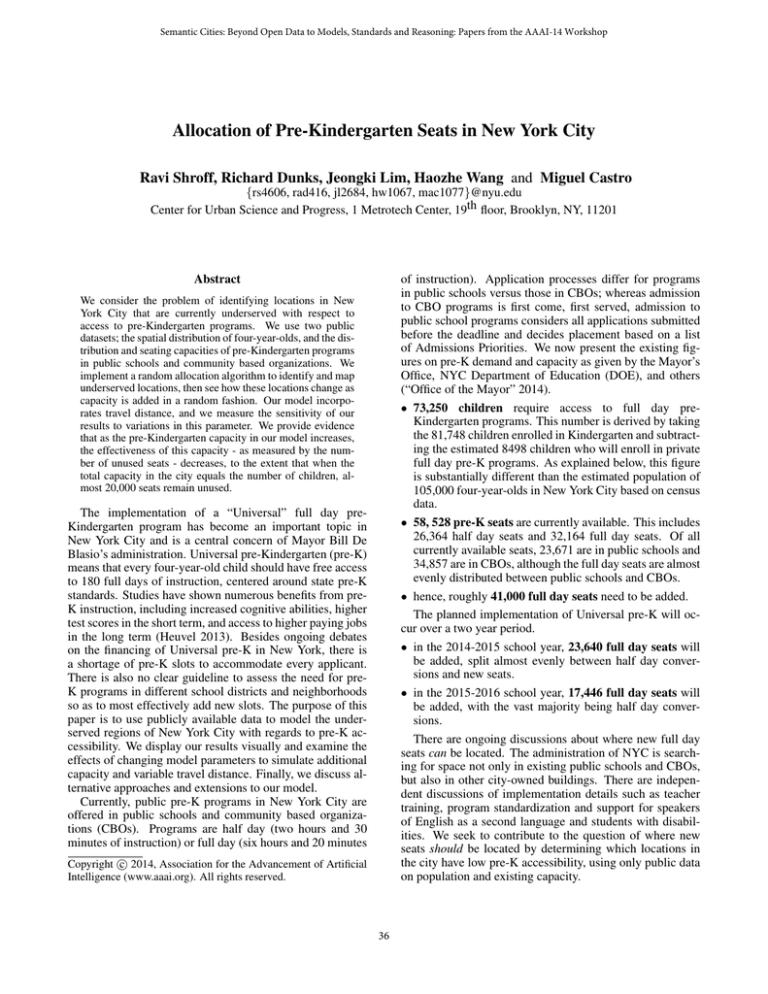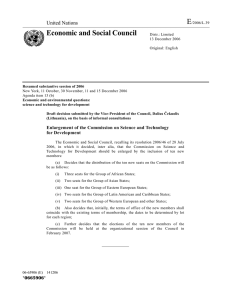
Semantic Cities: Beyond Open Data to Models, Standards and Reasoning: Papers from the AAAI-14 Workshop
Allocation of Pre-Kindergarten Seats in New York City
Ravi Shroff, Richard Dunks, Jeongki Lim, Haozhe Wang and Miguel Castro
{rs4606, rad416, jl2684, hw1067, mac1077}@nyu.edu
Center for Urban Science and Progress, 1 Metrotech Center, 19th floor, Brooklyn, NY, 11201
Abstract
of instruction). Application processes differ for programs
in public schools versus those in CBOs; whereas admission
to CBO programs is first come, first served, admission to
public school programs considers all applications submitted
before the deadline and decides placement based on a list
of Admissions Priorities. We now present the existing figures on pre-K demand and capacity as given by the Mayor’s
Office, NYC Department of Education (DOE), and others
(“Office of the Mayor” 2014).
• 73,250 children require access to full day preKindergarten programs. This number is derived by taking
the 81,748 children enrolled in Kindergarten and subtracting the estimated 8498 children who will enroll in private
full day pre-K programs. As explained below, this figure
is substantially different than the estimated population of
105,000 four-year-olds in New York City based on census
data.
• 58, 528 pre-K seats are currently available. This includes
26,364 half day seats and 32,164 full day seats. Of all
currently available seats, 23,671 are in public schools and
34,857 are in CBOs, although the full day seats are almost
evenly distributed between public schools and CBOs.
• hence, roughly 41,000 full day seats need to be added.
The planned implementation of Universal pre-K will occur over a two year period.
• in the 2014-2015 school year, 23,640 full day seats will
be added, split almost evenly between half day conversions and new seats.
• in the 2015-2016 school year, 17,446 full day seats will
be added, with the vast majority being half day conversions.
There are ongoing discussions about where new full day
seats can be located. The administration of NYC is searching for space not only in existing public schools and CBOs,
but also in other city-owned buildings. There are independent discussions of implementation details such as teacher
training, program standardization and support for speakers
of English as a second language and students with disabilities. We seek to contribute to the question of where new
seats should be located by determining which locations in
the city have low pre-K accessibility, using only public data
on population and existing capacity.
We consider the problem of identifying locations in New
York City that are currently underserved with respect to
access to pre-Kindergarten programs. We use two public
datasets; the spatial distribution of four-year-olds, and the distribution and seating capacities of pre-Kindergarten programs
in public schools and community based organizations. We
implement a random allocation algorithm to identify and map
underserved locations, then see how these locations change as
capacity is added in a random fashion. Our model incorporates travel distance, and we measure the sensitivity of our
results to variations in this parameter. We provide evidence
that as the pre-Kindergarten capacity in our model increases,
the effectiveness of this capacity - as measured by the number of unused seats - decreases, to the extent that when the
total capacity in the city equals the number of children, almost 20,000 seats remain unused.
The implementation of a “Universal” full day preKindergarten program has become an important topic in
New York City and is a central concern of Mayor Bill De
Blasio’s administration. Universal pre-Kindergarten (pre-K)
means that every four-year-old child should have free access
to 180 full days of instruction, centered around state pre-K
standards. Studies have shown numerous benefits from preK instruction, including increased cognitive abilities, higher
test scores in the short term, and access to higher paying jobs
in the long term (Heuvel 2013). Besides ongoing debates
on the financing of Universal pre-K in New York, there is
a shortage of pre-K slots to accommodate every applicant.
There is also no clear guideline to assess the need for preK programs in different school districts and neighborhoods
so as to most effectively add new slots. The purpose of this
paper is to use publicly available data to model the underserved regions of New York City with regards to pre-K accessibility. We display our results visually and examine the
effects of changing model parameters to simulate additional
capacity and variable travel distance. Finally, we discuss alternative approaches and extensions to our model.
Currently, public pre-K programs in New York City are
offered in public schools and community based organizations (CBOs). Programs are half day (two hours and 30
minutes of instruction) or full day (six hours and 20 minutes
c 2014, Association for the Advancement of Artificial
Copyright Intelligence (www.aaai.org). All rights reserved.
36
Data
time may actually decrease listed capacity. Finally, each
hexagon was also assigned to the school district with which
it overlapped most.
We use two publicly available datasets in our model; the spatial distribution of the four-year-old population and the locations and capacities of pre-Kindergarten facilities in New
York City.
The distribution of four-year-olds was derived from the
2012 five-year aggregated American Community Survey
(ACS). The ACS groups the population into various age
bands for reporting purposes. To estimate the number of
four-year-olds living in a particular census tract, the population under age five was assumed to be evenly distributed
among children aged zero to four, and divided by five to provide the population of four-year-olds. Note that this method
gives a total four year old population of roughly 105,000 in
NYC, significantly higher than the population estimated by
the Mayor’s office and DOE. We will use “child” and “fouryear-old” interchangeably.
The locations of pre-K facilities in public schools were
gathered from the Pediacities open data portal (PED 2013),
then capacity information was extracted from NYC’s open
data portal (DOE 2013). Of the 1,406 pre-K sites listed by
the DOE, we removed 29 sites which no longer have Pre-K
seats for the 2013-2014 school year.
The locations of the roughly 850 pre-K facilities in CBOs
were obtained from both the Pediacities open data portal and
a report from the Mayor’s office (“Department of Education” 2014). The six sites which appear to no longer host
pre-K seats in the Pediacities dataset have been removed
from the 855 listed. We were unable to obtain precise CBO
capacity information, except for the programs at two sites,
Baychester Academy and the Staten Island School of Civic
Leadership, with respective reported capacities of 36 and 18
students. Subtracting these 54 seats from the total CBO capacity of 34,857 (listed in the Mayor’s report) gives an estimated 41 seats per facility. Hence, each CBO for which the
actual capacity is unknown has been assigned a capacity of
41.
For the purposes of this analysis, we subdivided the city
into 2930 equal regular hexagons of side length roughly 350
meters. This created a common spatial unit of analysis, allowing data to be aggregated as necessary to compare capacity within various political, administrative, and other delineations. The size was chosen to provide compatibility with
transit time data, to be incorporated into future work. The
population of four-year-olds in a particular hexagon was determined by the percent overlap between the hexagon each
census tract as in (Maantay, Maroko, and Herrmann 2007).
The census tracts used here are those released by the NYC
Department of City Planning (DCP). These are clipped to
the shoreline and provide a more reliable estimate of the
area of the census tract in which population actually resides
than tract boundaries provided by the Census Bureau. The
pre-K capacities were summed for all sites located within a
hexagon, with separate figures for public school and CBO
capacities. No distinction was made between part time and
full time seats, thus a site with 18 morning seats and 18 afternoon seats would have a capacity of 36. This is consistent
with how DOE reports capacity figures in their annual report. Note that conversion of part time pre-K seats to full
Algorithm
Our allocation algorithm (Algorithm 1, below) uses Monte
Carlo methods to determine areas of New York City underserved in terms of pre-Kindergarten program access. The
input consists of the geographic distribution of four-yearolds and current public school and CBO pre-K capacities for
each of the 2930 hexagons described above. We simulated
the ability of parents to take their children to nearby preK seats by creating for each hexagon H a list of “nearby”
hexagons, defined to be those hexagons overlapping a disc
of fixed radius (the “travel distance”) centered at the given
hexagon. We assume that although a child in H may attend any CBO pre-K program in any nearby hexagon, he or
she may only attend those public school pre-K programs in
nearby hexagons in the same school district as H. This assumption is consistent with public school pre-K admissions
criteria, which give strong preference to an applicant whose
residence is in the same school district as the target school.
Each hexagon H has resident population of children PH ,
current number of assigned public school and CBO students
ps
cbo
respectively, public school and CBO capacities
SH
and SH
ps
cbo
respectively, a list of nearby hexagons FH =
CH and CH
{F1 , . . . , FjH } in the same school district as H, and a list
of all nearby hexagons GH = {G1 , . . . , GkH } (so FH ⊆
ps
cbo
are set to zero and PH is set to
GH ). Initially, SH
and SH
0
PH , the initial resident population.
We say any hexagon K is a non-full neighbor of H if
ps
ps
cbo
cbo
K ∈ FH and SK
< CK
or K ∈ GH and SK
< CK
. We
say H is usable if it has at least one child (PH > 0), and at
least one non-full neighbor.
The algorithm then works as follows. While there exists
at least one usable hexagon, randomly choose such a usable
H and randomly choose a non-full nearby hexagon K from
either FH or GH . Decrement Hs resident population PH
by 1 and if K was chosen from FH , increment Ks assigned
ps
public school students SK
by 1, otherwise increment K’s
cbo
assigned CBO students SK
by 1.
When the algorithm terminates, for each hexagon H com0
pute the output statistic PH /PH
, the percentage of resident
children in H that were unable to be allocated to a pre-K
spot. We chose to run the algorithm six times due to computational limitations and average the output statistics. Finally,
we visualized the averaged output statistic by creating a map
where each hexagon was shaded from black to light grey
based on the output statistic (black means all children were
unallocated and light grey means all children were allocated
to pre-K seats). Hexagons that did not possess children to
begin with are white.
Results
We ran our algorithm multiple times, varying two parameters, the total capacity and travel distance. Our first map
displays the results of our algorithm where we have set the
travel distance to two kilometers, roughly how far one may
37
Algorithm 1
Input: Hexagons H = {Hn }2930
n=1 ,
ps
ps
cbo
cbo
Hn = {PHn , SH
,
S
,
C
H
Hn , CHn , FHn , GHn }
n
n
Initialize parameters:
0
PHn = PH
{∀n}
n
ps
SHn = 0 {∀n}
cbo
SH
= 0 {∀n}
n
X = [H ∈ H s.t. H usable]
while length(X ) 6= 0 do
randomly choose H ∈ X
randomly choose non-full neighbor K of H from either
FH or GH
if K chosen from FH then
ps
ps
SK
= SK
+1
else
cbo
cbo
SK
= SK
+1
end if
PH = PH − 1
X = [H ∈ H s.t. H usable]
end while
Output: Pairs {(n, on )}2930
n=1
P
0
where on = PH0 n if PH
6= 0, and on = −1 otherwise
n
of the “underserved” clusters are in historically low-income
areas or areas requiring long transit times to the rest of the
city. The results of this simulation yield 49,849 unallocated
children, or merely 31 unused pre-Kindergarten seats. Note
that the number of unused seats are computed according to
unused seats = total seats − allocated children,
where “allocated children” is the difference of the total number of children and the number of children unallocated. We
next examine the sensitivity of these numbers to varying
travel times. In Table 1, we increase travel distance by increments of 200 meters to a maximum travel distance of 3000
meters (roughly how far one may travel in 20 minutes by
foot or public transit). We notice that the number of unallocated children and unused seats varies very little, since most
seats are already occupied, and we expect the number of unused seats to generally decrease as travel distance increases.
Travel distance
2000m
Hn
2200m
2400m
travel by foot or public transport in New York City in 15
minutes. As explained above, this map shades each hexagon
from light grey to black based on the percentage of resident
children that weren’t allocated a pre-K seat (black means
a high percentage of children remained unallocated). The
school district boundaries are overlaid. Note that in our
model there are a total of 105,376 children and 55,558 available seats. Also note that while we have chosen to map
the percentages of unallocated children rather than the total number, the two maps are virtually identical.
2600m
2800m
3000m
Unallocated
children
(stdev)
49,849
(σ =10.29)
49,587
(σ =15.39)
49,851
(σ =14.27)
49,844
(σ =15.84)
49,840
(σ =17.92)
49,846
(σ =12.80)
Unused seats
31
39
33
26
22
28
Table 1: Varying travel distance, no added capacity
Next, we run the algorithm where we again set travel distance to 2000 meters, but now randomly add 25,000 seats
across the city. We pick 250 hexagons at random, increment
public school capacity by 100 in 125 of these hexagons, and
CBO capacity by 100 in the other 125 hexagons. The resulting map appears in Figure 2. We note that many areas
of the map are significantly improved in terms of percentage
of children unallocated, though the large clusters in the center and top of the map remain. In this simulation there are
30,937 children unallocated and 6,119 unused seats. Hence
roughly 24.4 percent of the added capacity remains unused,
even though over 29 percent of children remain unallocated.
In Table 2 we vary travel distance again and see how
the number of unallocated children and unused seats varies.
We see a slight reduction in both figures (unused seats decrease by about 11 percent) as travel distance increases from
2 kilometers to 3 kilometers. This suggests that a modest
increase in travel distance is not enough to significantly reduce the inefficiencies created by randomly adding 25,000
pre-Kindergarten seats.
For our final run, the travel distance is again 2000 meters, but we vary capacity by randomly adding 50,000 seats
across the city, so the total number of seats is now 105,558,
Figure 1: Travel distance of 2000 meters, no added capacity
Figure 1 allows the identification of spatial clusters of
hexagons with poor accessibility to pre-K programs. For
those familiar with the geography of New York City, many
38
Figure 2: Travel distance of 2000 meters, 25,000 seats added
capacity
Travel distance
2000m
2200m
2400m
2600m
2800m
3000m
Unallocated
children
(stdev)
30,937
(σ =27.27)
30,674
(σ =40.57)
30,723
(σ =26.32)
30,364
(σ =53.84)
30,226
(σ =13.98)
30,261
(σ =68.01)
Figure 3: Travel distance of 2000 meters, 50,000 seats added
capacity
Unused seats
capacity.
Travel distance
6,119
5,856
2000m
5,905
2200m
5,546
2400m
5,408
2600m
5,443
2800m
3000m
Table 2: Varying travel distance, 25,000 seats added capacity
Unallocated
children
(stdev)
19,681
(σ =62.43)
19,200
(σ =43.95)
19,184
(σ =31.95)
18,514
(σ =59.99)
18,232
(σ =25.99)
18,242
(σ =57.33)
Unused seats
19,681
19,200
19,184
18,514
18,232
18,242
Table 3: Varying travel distance, 50,000 seats added capacity
which is 182 more than the 105,376 children in the city. We
pick 500 hexagons at random, incrementing public school
capacity by 100 in half of these hexagons, and CBO capacity
by 100 in the other half. The resulting map appears in Figure
3. Although there is significant improvement in this map as
compared to Figures 1 and 2, there are still a number of underserved spatial hexagon clusters. In this simulation there
are 19,681 children unallocated and 19,681 unused seats (we
ignore the 182 extra seats that would always remain unused).
Hence almost 40 percent of the added capacity remains unused, even though 20 percent of children remain unallocated
and there are more seats than children.
In Table 3 we vary travel distance and notice that as distance increases, there is again only a modest reduction in the
number of unallocated children and unused seats. This again
implies that an increase of 50 percent in travel distance is
not nearly enough to reduce the total number of unallocated
children to zero, given the 50,000 seats added to the original
Discussion and Conclusion
Any strategy for adding pre-K capacity to minimize unallocated children should be measured by its performance
against the random assignment benchmark we have constructed in this paper. However, several aspects of this
problem make it challenging with respect to implementing
a straightforward optimization solution.
First is the difficulty of accurately measuring assumptions
and input parameters. For example, it may be incorrect to
assume parents seek to minimize the distance between their
home and choice of pre-K facility; they make take their child
to a program near their place of work. It is also difficult to
measure the capacity of individual CBO programs (the DOE
did not have this information readily available) and even the
estimated number of children who require access to pre-K
39
Heuvel, K. 2013. Oklahoma is schooling the nation on early
education. The Washington Post.
Holmberg, K.; Rönnqvist, M.; and Yuan, D. 1999. An exact
algorithm for the capacitated facility location problems with
single sourcing. European Journal of Operational Research
113(3):544–559.
Maantay, J.; Maroko, A.; and Herrmann, C. 2007. Mapping population distribution in the urban environment: The
cadastral-based expert dasymetric system (ceds). Cartography and Geographic Information Science 34(2):77–102.
“Office of the Mayor”. 2014. Ready to launch: New york
city’s implementation plan for free, high-quality, full-day
universal pre-kindergarten. Technical report.
2013.
Universal
pre-k
locations.
http://nycdata.pediacities.com/dataset/universalpre-k-locations/resource/88c86aff-c965-4491-9b043b1ddab36009.
in the first place. According to census data, we estimate
there are 105,000 four-year-olds but the city reported only
73,250 require a public pre-K program. Even incorporating
the city’s estimate of 8,498 private pre-K attendees, there is
still a difference of over 20,000 children.
Second is the necessary flexibility and robustness of a
solution. The selection of locations for additional preKindergarten facilities may occur at different points in time,
and change due to policy (e.g. it is politically expedient to
place facilities in a certain neighborhood) or unforeseen circumstances (such as a CBO not passing a health inspection).
A solution that is very sensitive to small changes in input parameters would not be the best choice to implement in New
York.
Third is the issue of scale. With the number of children
and existing pre-K locations already in the tens of thousands,
an optimization solution may not be computationally costeffective when parameter measurements are also uncertain.
Additional complications when building a more detailed
model of pre-K accessibility include uncertainty in how the
spatial distribution and total population of four-year-olds
will vary with time, as well as potential switches from private pre-K programs to public pre-K. We would like to incorporate more accurate transit time data to account for differences between bus, subway, and walking time, rather than
the simple distance-based estimation in our model. Finally,
we plan to incorporate a differential analysis of half day versus full day programs, as children occupying the same CBO
for different morning and afternoon programs may be displaced if that CBO only offers full day programs.
We do anticipate that the optimal strategy to assign children to programs will incorporate both linear optimization
techniques (to model public school program assignment)
and stochastic aspects to model CBO program selection.
Note that the question under consideration in this paper is
closely related to the facility location problem from operations research, specifically the single-source capacitated
facility location problem (Holmberg, Rönnqvist, and Yuan
1999). Although we have chosen reasonable input parameters for our model based on public data, with more accurate,
not necessarily public data (for example, specific CBO capacities and parent preference information) we could better
model the areas of New York City that should be targeted for
increased pre-K capacity.
Acknowledgements
The authors would like to acknowledge Dr. Sharad Goel
and Professors Manuela Veloso and Theodoros Damoulas
for their assistance and stimulating conversations regarding
this work.
References
“Department of Education”. 2014. Pre-kindergarten directory 2014-2015. Technical report.
2013. Enrollment capacity and utilization reports district
1-32. https://data.cityofnewyork.us/Education/EnrollmentCapacity-and-Utilization-Reports-Distri/my4g-bvvs.
40







